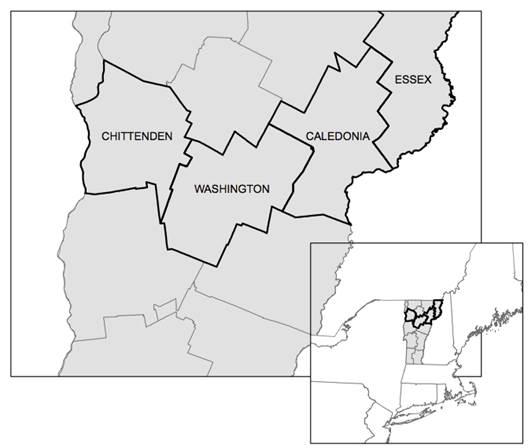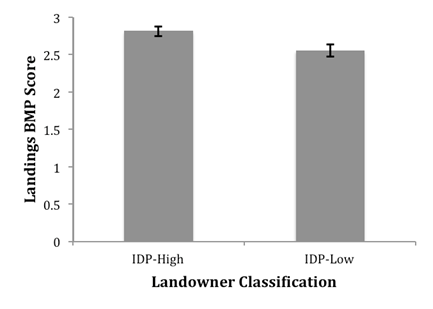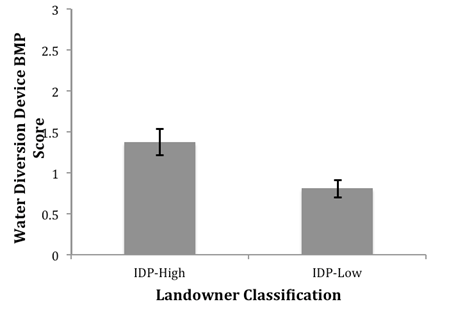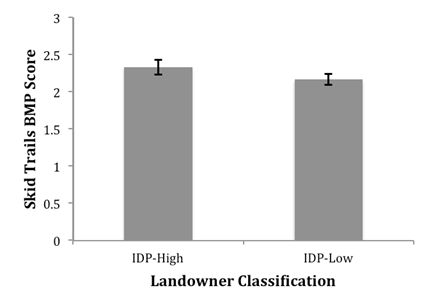 |
December 2014
|
December 2014 // Volume 52 // Number 6 // Research In Brief // v52-6rb3
Does Landowner Awareness and Knowledge Lead to Sustainable Forest Management? A Vermont Case Study
Abstract
Family forest owners control 40% of forestland in the United States. Timber harvesting on family forests represents a critical component of the nation's wood supply. We examined how awareness and knowledge translated into actual forest management practices. We conducted field surveys on 59 family forest properties, coupled with a landowner survey designed to measure landowner engagement. We determined that engaged landowners implemented silviculture and Best Management Practices at a higher level than their less engaged counterparts. Improvement was needed across the board. Forestry Extension professionals should continue to promote and re-enforce awareness and knowledge among landowners.
Introduction
Family forest owners (FFO) own nearly 40% of the total forestland in the United States (Butler, 2008). These lands produce numerous benefits such as clean water, timber, recreation, wildlife habitat, and many other ecosystem services. Although FFO have become increasingly interested in non-timber forest products and benefits, timber harvesting on family forests has increased in recent decades (Kluender & Walkingstick, 2000; Smith, Miles, Vissage, & Pugh, 2004). Past studies have indicated that harvesting on family forests is often exploitative, leading to negative impacts on the vitality, stability, and productivity of forested ecosystems (Fajvan, Grushecky, & Hassler, 1998; Kenefic, Sendak, & Brissette, 2005; Munsell & Germain, 2007; Munsell, Germain, & Munn, 2008). Promoting sustainable forest management on FFO lands is difficult due to the diversity of owner demographics, as well as a myriad of other factors, including management goals and objectives, motivations, needs, preferences, intentions, attitudes, and knowledge (Anderson, 2006; Salmon, Brunson & Kuhns, 2006; Butler et al., 2007).
Study Objectives
Our study examined the relationship between landowner demographics and engagement with forest management practices across four counties in Vermont. Sustainable forest management was measured by the degree of silviculture and level of Best Management Practices (BMP) implementation. We used Rogers' (2003) Diffusion of Innovations' Innovation-Decision Process (IDP) as a theoretical foundation to measure landowner engagement. The innovation in this case is sustainable forest management. The IDP model states that for landowners to adopt an innovation they must first go through the stages of awareness and knowledge, followed by persuasion, which leads to a decision and implementation, and later adoption or rejection of the innovation. Past research used IDP to examine the decision and motivations of landowners to regenerate harvested stands (Doolittle & Straka, 1987). Additionally, it was used to describe how FFO beliefs and experiences toward management affect management planning (Gramann, Marty, & Kurtz, 1985). More recently, IDP was used to examine BMP implementation in the New York City watershed (Munsell, Germain, Bevilacqua, & Schuster., 2006). In addition to forestry, IDP has been instrumental for Extension professionals across many disciplines, including agriculture and horticulture, particularly with respect to program evaluation. The key to program effectiveness is the degree to which participants are adopting innovations (Hubbard & Sandmann 2007).
Methods
Family forest owners with at least 25 acres of forestlands (Vickery, Germain, & Bevilacqua, 2009) were identified using geographic information system tax parcel data from Chittenden, Washington, Caledonia, and Essex counties in Vermont (Figure 1).
Figure 1.
Study Area in Northern Vermont

Two waves of mailers were sent to 2,144 eligible properties. Landowners were asked to return a response card if they had harvested timber in the last 5 years, were willing to allow a field visit of their harvested stands, and participate in an interview. A total of 113 eligible family forest owners responded. Of the 113 eligible FFO, a simple random sample of 59 was selected and visited during the summer of 2010.
Field measurements were conducted on each property to evaluate silviculture and BMP implementation after harvest operations. On each property a systematic grid was used to inventory the harvested area, including stumps for pre-harvest estimates. The field procedures were based on methods used by Munsell, Germain, and Munn (2008) and VanBrakle, Germain, Munsell, and Stehman (2013). The recent harvest activity was rated based on a silvicultural score ranging from zero to one, where zero indicates no evidence of the application of silvicultural practices and one indicates strong evidence of a silvicultural harvest. BMP scores are on a scale of zero to three, where zero indicates BMPs were not applied, one indicates they were applied with major deviations, two indicates they were applied with minor deviations, and three indicates that BMPs were correctly applied and functional at the time of the visit. Detailed field methods for the study are available in Maker, Germain, and Anderson (2013).
The landowner survey was conducted to evaluate the level of landowner engagement. Each respondent was interviewed after the field inventory and asked questions pertaining to demographics, reasons for owning forestland, and land use and management. Three stages of IDP (knowledge, persuasion, and decision) were measured using a summated rating scale with each scale combining a number of statements to increase reliability and better capture broad complex concepts (DeVellis, 2003). Owners were provided a definition of sustainable forest management before being asked to respond to five statements for knowledge, eight for persuasion, and four for decision. After each statement, respondents were asked to respond from 1=strongly disagree to 7=strongly agree, with 4 being neutral. All scales received acceptable Cronbach's reliability alpha scores, with 0.79 for knowledge, 0.90 for persuasion, and 0.93 for decision (Carmines & Zeller, 1979) (Table 1).
| Sustainable Forest Management: Forest management that results in a supply of multiple renewable resources including timber production, and recreation activities without impairing the forest future potential. | |
| Stages in Innovation-Decision (Cronbach's α) | Indicator |
| Knowledge (0.79) |
|
| Persuasion (0.90) |
|
| Decision (0.93) |
|
Family forest owners were classified into two groups depending on their mean scores for knowledge, persuasion, and decision. Owners classified as IDP-High were defined as strongly agreeing (mean score of 6 or above) with each stage of the Innovation-Decision Process. This group was highly knowledgeable, saw the advantages to using sustainable forest management, and decided to implement. The IDP-Low owners were defined as FFO who had a mean score of less than 6 in at least one of the three stages of the Innovation-Decision Process. This group represented FFO who were either less aware or less knowledgeable about sustainable practices, did not see its advantages, or decided not to consider sustainable forest management during their last harvest.
For categorical variables, differences in proportions between the two IDP groups were assessed using chi-square tests. Continuous variables were examined using independent two-sample t-tests to compare the difference in mean scores between each group. Statistical significance for all tests was determined based on a significance level of α=0.05. Pearson's correlation was used to quantify the association between knowledge, persuasion, decision, and implementation during the Innovation-Decision Process.
Results
Late respondents were identified as the 19 landowners who responded to the second wave of mailers. Independent two sample t-tests at α=0.05 found that there were no statistically significant differences between early and late respondents when comparing knowledge, persuasion, and decision. In addition, silviculture and BMP scores did not differ statistically between early and late respondents. These results suggest there is negligible non-response bias (after Salant & Dillman, 1994; Lindner, Murphy, & Briers, 2001).
Family forest owners who participated in our study (n=59) owned forestland ranging from 28 to 705 acres, with a mean of 110 acres. These FFO were well educated, with 73% being college graduates. A high percent (73%) of participating landowners were enrolled in the Vermont Use Value Appraisal program (Table 2).
| All | Innovation-Decision Process | |||||
| IDP-High | IDP-Low | |||||
| n=59 | n=25 | n=34 | ||||
| Prop | SE | Prop | SE | Prop | SE | |
| Landowner Characteristics | ||||||
| Absentee (0-1) | 0.34 | 0.06 | 0.26 | 0.09 | 0.39 | 0.08 |
| College Education (0-1) | 0.73 | 0.06 | 0.78 | 0.09 | 0.69 | 0.08 |
| Owned for 20 Years (0-1) | 0.63 | 0.06 | 0.61 | 0.10 | 0.64 | 0.08 |
| Inheritor (0-1) | 0.15 | 0.05 | 0.13 | 0.07 | 0.17 | 0.06 |
| Involvement | ||||||
| Use Value Appraisal (Current Use) (0-1) | 0.73 | 0.06 | 0.87 | 0.07 | 0.64 | 0.08 |
| Management Plan (0-1) | 0.75 | 0.06 | 0.91* | 0.06 | 0.64* | 0.08 |
| Conservation Easement (0-1) | 0.14 | 0.04 | 0.13 | 0.07 | 0.14 | 0.06 |
| Education Event (0-1) | 0.31 | 0.06 | 0.43 | 0.11 | 0.22 | 0.07 |
| Forester | ||||||
| Involved In Harvest (0-1) | 0.59 | 0.06 | 0.65 | 0.10 | 0.56 | 0.08 |
| Administered Harvest (0-1) | 0.47 | 0.07 | 0.48 | 0.11 | 0.47 | 0.08 |
| Engagement Drivers | Mean | SE | Mean | SE | Mean | SE |
| Knowledge (1-7) | 6.12 | 0.14 | 6.81* | 0.07 | 5.69* | 0.19 |
| Persuasion (1-7) | 5.29 | 0.19 | 6.32* | 0.05 | 4.64* | 0.25 |
| Decision (1-7) | 5.60 | 0.25 | 6.37* | 0.27 | 5.10* | 0.35 |
|
*Indicates that the chi-square test or two-sample t-test was statistically significant for the comparison of IDP-High to IDP-Low (α= 0.05) |
||||||
Even though all participating landowners had recently harvested timber, few valued timber production as a primary reason for owning property. The top reasons for owning property were to enjoy beauty and scenery, and recreation (other than hunting and fishing) and to protect nature and biological diversity.
Overall, the mean score for silviculture (0-1) was 0.47, approximately the mid-point between no silviculture and a carefully implemented silvicultural harvest. BMP mean scores (0 – 3) for landings and skid trails were 2.7 and 2.2. These scores indicate that BMPs were being implemented on landings and skid trails with only minor deviations. Water diversion device implementation was less effective and implemented with major deviations throughout the study, with a mean score of 1.0 (0 – 3) (Maker, Germain, & Anderson, 2013).
The IDP analysis separated FFO into 25 IDP-High and 34 IDP-Low owners. Nearly all (87%) of the IDP-High owners were part of the Vermont Use Value Appraisal program, which requires a management plan, whereas only 64% of the IDP-Low owners were enrolled in the Vermont Use Value Appraisal program and had a management plan for their properties (Table 2). IDP-High owners earned a significantly higher mean score for silviculture than IDP-Low owners (Figure 2).
Figure 2.
Silviculture Scores (0 – 1) for Landowners Classified Using the Innovation-Decision Process

Additionally, IDP-High owners had significantly better BMP implementation scores for landings (Figure 3) and water diversion devices (Figure 4) than IDP-Low landowners. There was no statistical difference between BMP implementation on skid trails for IDP-High or IDP-Low owners (Figure 5). IDP-High FFO implemented BMPs with only minor deviations on skid trails and landings, and with major deviations for water diversion devices, while IDP-Low owners were less successful at implementing BMPs, with their lowest score on water diversion devices, which showed BMPs not applied or applied with major deviations.
Figure 3
Best Management Practice Implementation Scores (0 – 3) on Landings for Landowners Classified Using the Innovation-Decision Process

Figure 4.
Best Management Practice Implementation Scores (0 – 3) on Water Diversion Devices for Landowners Classified Using the Innovation-Decision Process

Figure 5.
Best Management Practice Implementation Scores (0 – 3) on Skid Trails for Landowners Classified Using the Innovation-Decision Process

The Innovation-Decision Process was analyzed using Pearson's correlation. We found that knowledge showed a strong correlation with persuasion (p=0.01, r= 0.69) and persuasion was a strong predictor of a landowner's decision to use sustainable practices (p=0.01, r=0.74). In terms of drivers of FFO engagement, a landowner's decision was significantly correlated to degree of silviculture (r=0.25), level of BMP implementation for skid trails (r=0.46), and water diversion devices (r=0.43) (Table 3). In addition, both knowledge and persuasion showed significant correlations with degree of silviculture and level of BMP implementation on skid trails and water diversion devices (Table 3).
| Driver | Silviculture | Skid Trails | Water Diversion Devices | Landings |
| IDP Knowledge | r=0.25* | r=0.26* | r=0.32* | r=0.19 |
| Persuasion | r=0.38* | r=0.34* | r=0.38* | r=0.25 |
| Decision | r=0.25* | r=0.46* | r=0.43* | r=0.19 |
|
* Indicates Pearson's correlation is statistically significant at α=0.05 |
||||
Discussion
The study reported here indicates that more engaged FFO (IDP-High) demonstrated better implementation of silviculture and BMPs than their less engaged counterparts. Similar to previous studies looking at management by FFO (Fajvan, Grushecky, & Hassler, 1998; Kenefic, Sendak, & Brissette, 2005; Munsell & Germain, 2007), there were indications of exploitative harvesting practices on several woodlots. Nonetheless, we are optimistic about the prospects for sustainable forest management practices overall—primarily due to the positive influence of the Vermont Use Value Appraisal in engaging landowners and monitoring forest management activities.
The findings with respect to individual drivers (knowledge, persuasion, decision) are informative for Extension educators charged with promoting forest stewardship on family forests. For instance, the IDP drivers—knowledge, persuasion and decision—were all significantly correlated with silviculture and most of the BMP indicators. Overall, we conclude that no one driver serves as a magic bullet for understanding landowner behavior, because context will have a major influence on management practices.
The disconnect between landowner drivers and actual forest management practices, as expressed by relatively low correlation values, has been clearly documented on FFO forestlands (Harmon & Jones, 1997; Munsell et al., 2006; Munsell, Germain, Luzadis, & Bevilacqua, 2009). The burden of implementing silviculture and BMPs must be shared by the remaining two sides of the forest management triangle—foresters and loggers. Daniels, Kilgore, and Jacobson (2010) suggested that landowner decisions are motivated by three main factors: doing the "right thing," benefit to the landowner, and forest continuity. The study of admittedly motivated landowners found that most landowners had good intentions for management, showing they wanted to do the "right thing" with their woodlots, but came up short on the level of silviculture and BMP implementation. Given the high percentage of "engaged" landowners in our sample, we suggest our correlation values for FFO drivers represent a ceiling. The remainder of the "heavy lifting" to ensure the implementation of sustainable forest management rests on the shoulders of "change agents" such as foresters, loggers and Extension professionals.
Regardless of the discipline and innovation in question, relative advantage as perceived by the participant has a finite influence on adoption rate. Change agents are needed to help the participant wrestle with other important factors associated with adoption such as compatibility, complexity, trialability, and observability. A management plan may help in this regard.
The Vermont Use Value Appraisal program requirement of a management plan facilitates direct contact with a forester (change agent), which can increase landowner knowledge and engagement (Munsell & Germain, 2004; Ma, Kittredge, & Catanzaro, 2012). When FFO better understand their forests and are active in management, they are more apt to become better stewards (Munsell & Germain, 2004). Management plans alone, however, cannot guarantee positive results on the ground. Caron, Germain, and Anderson (2012) found that landowners with management plans were more knowledgeable about forestry and watershed management than non-plan owners, but this higher level of knowledge was not reflected in better forest stocking of plan owners. Furthermore, VanBrakle et al. (2013) reported that FFO with subsidized management plans did not outperform their counterparts without management plans when implementing BMPs. The bottom line is that management plans can facilitate landowner engagement, but there is no guarantee that engagement will have an impact on forest management activities.
Conclusion
Some have contended that providing Extension to engaged landowners is preaching to the choir, because they are already practicing good management (Butler et al., 2007; Ma, Kittredge, & Catanzaro, 2012). Our study suggests that this is not necessarily the case. Intentions may be consistent with sustainable forest management, but actual practices may fall short for a variety of reasons, including the complexity of the innovation, financial constraints, and long timelines, as well as the lack of full participation and performance from foresters and loggers. Extension activities, regardless of discipline, can serve as re-enforcement tools for the "engaged choir" as well as an introduction to innovation for the "less engaged".
References
Anderson, R. C. (2006). Forestry Mini College: A cost-effective way to educate non-industrial private forest landowners. Journal of Extension [On-line], 43(3) Article 3IAW4. Available at: http://www.joe.org/joe/2006june/iw4.php
Butler, B. J. (2008). Family forest owners of the United States, 2006. General Technical Report NRS 27. Newtown Square, PA: U.S. Department of Agriculture, Forest Service, Northern Research Station.
Butler, B. J., Tyrrell, M., Feinberg, G., Vanmanen, G., Wiseman, L., & Wallinger, S. (2007). Understanding and reaching family forest owners: Lessons from social marketing research. Journal of Forestry, 100, 348–357.
Carmines, E. G., & Zeller, R.A. (1979). Reliability and validity Aassessment. Beverly Hills: Sage Publications, pp. 79.
Caron, J., Germain, R. H., & Anderson, N. (2012). Parcelization and land use: A New York City Watershed case study. Northern Journal of Applied Forestry, 29(2): 74-80.
Daniels, S. E., Kilgore, M. A., & Jacobson, J. L. (2010). Examining the compatibility between forestry incentive programs in the US and practice of sustainable forest management. Forests, 2010:49–64.
DeVellis, R. F. (2003). Scale development: Theory and applications. Thousand Oaks, CA: SAGE Publications.
Doolittle, L., & Straka, J. L. 1987. Regeneration following harvest on nonindustrial private pine sites in the South: A diffusion of innovations perspective. Southern Journal of Applied Forestry, 11:37–40.
Fajvan, M. A., Grushecky, S. T., & Hassler, C. C. (1998). The effects of harvesting practices on West Virginia's wood supply. Journal of Forestry, 96(5), 33-39.
Gramann, J. H., Marty, T. D., & Kurtz, W. B. (1985). A logistic analysis of the effects of beliefs and past experience on management pans for nonindustrial private forests. Journal of Environmental Management, 20:347–356.
Harmon, A.H., & Jones, S. B. (1997). Forestry demonstrations: What good is a walk in the woods? Journal of Extension [On-line], 35(1) Article 1RIB3. Available at: http://www.joe.org/joe/1997february/rb3.php
Hubbard, W., & Sandmann, L. (2007). Using diffusion of innovation concepts for improved program evaluation. Journal of Extension [On-line], 45(5) Article 5FEA1 Available at: http://www.joe.org/joe/2007october/a1.php
Kenefic, L. S., Sendak, P. E., & Brissette, J.C. (2005). Comparison of fixed diameter‐limit and selection cutting in northern conifers. Northern Journal of Applied Forestry, 22:77–84.
Kluender, R. A., & Walkingstick, T. L. (2000). Rethinking how nonindustrial landowners view their lands. Southern Journal of Applied Forestry, 24:150–158.
Lindner, J. R., Murphy, T. H., & Briers, G.E. (2001). Handling nonresponse in social science research. Journal of Agriculture Education, 42:43–53.
Ma, Z., Kittredge, D. B., & Catanzaro P. (2012) Challenging the traditional forestry Extension model: Insights from the woods forum program in Massachusetts. Smallscale Forestry. 11:87–100.
Maker, N., Germain, R. H., & Anderson, N. (2013). Sustained yield management on family woodlands In Vermont's Northern Forest. Journal of Forestry, (in press).
Munsell, J., & Germain, R. H. (2004). Forestry Extension participation and written forest management plan use in New York City's water supply system. Journal of Extension [On-line], 43(2) Article 2RIB7. Available at: http://www.joe.org/joe/2004april/rb7.php
Munsell, J. F., & Germain, R. H. (2007). Woody biomass energy: An opportunity for silviculture on nonindustrial private forestlands in New York. Journal of Forestry, 105(8), 398-402.
Munsell, J. F., Germain, R. H., Bevilacqua, E., & Schuster, R. M. (2006). Voluntary best management practice implementation by nonindustrial private forestland owners in New York City's water supply system. Northern Journal of Applied Forestry, 23:133–140.
Munsell, J. F., Germain, R. H., Luzadis, V .A., & Bevilacqua, E. (2009). Owner intentions, previous harvests, and future timber yield on fifty working nonindustrial private Fforestlands in New York State. Northern Journal of Applied Forestry. 26:45–51.
Munsell, J. F., Germain, R. H., & Munn, I. A. (2008). A tale of two forests: Case study comparisons of sustained yield management on Mississippi and New York nonindustrial private forestland. Journal of Forestry, 106(8), 431-439.
Rogers, E. M. (2003). Diffusion of innovations. 5th ed. New York: Free Press.
Salant, P., & Dillman, D.A. (1994). How to conduct your own survey. New York: John Wiley and Sons.
Salmon, O., Brunson, M., & Kuhns, M.. (2006). Benefit‐based audience segmentation: A tool for identifying nonindustrial private forest (NIPF) owner education needs. Journal of Forestry, 104:419–425.
Smith, W. B., Miles, P. D., Vissage, J. S., & Pugh, S. A. 2004. Forest Resources of the United States, 2002. St. Paul, MN: USDA Forest Service.
VanBrakle, J., Germain, R. H., Munsell, J., & Stehman, S. (2013). Do forest management plans increase BMP implementation on family forests? A formative evaluation in the NYC Watershed. Journal of Forestry, 111(2):108-114.
Vickery, B., Germain, R. H., & Bevilacqua, E. (2009). Urbanization's impact on sustained yield management as perceived by forestry professionals in Central New York. Forest Policy and Economics, 11:42–49.




